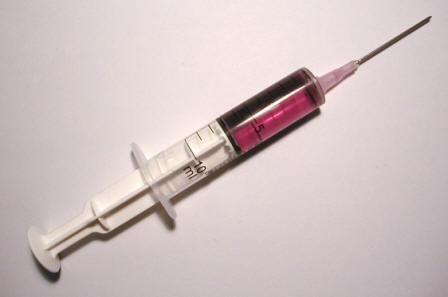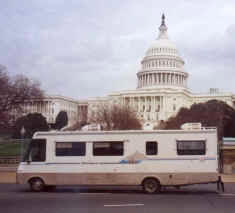 Riley
Croghan Riley
CroghanCORE 116 Spring 2007 |
The AIDS Epidemic in Washington, DC Paper Three: Moving Forward |
MOVING FORWARD
IDU Population

http://www.rutlandplastics.co.uk/images/pc%20syringe.jpg
The Risk
One of the groups currently being hit the hardest by AIDS in D.C. is intravenous drug users (referred to here as IDUís). The IDU population is unique in that, unlike most other high-risk groups, it affects all genders, races and orientations (8). Still, AIDS rates are highest in black male and female populations; in fact, the AIDS rate is currently higher in black females alone than in all white males and females (7). The IDU group in DC, and in the rest of the world, is particularly at risk. A recent study found that sharing non-sterile needles for IDU use is 12 times as risky as performing oral sex on a male, and significantly more risky than unprotected receptive anal intercourse (8), but many of the members in the IDU group are unaware of the risk. If we remember the correlations analyzed earlier in this website, many of the wards in DC with high AIDS rates also have low education rates; though this did not prove to be statistically significant, it is a disturbing trend.
According to a recent prevention plan developed by the DC Department of Health, IDUís donít only engage in risky behavior; they are slightly less likely than other high risk groups to seek prevention services. The barriers we face to reaching this population arise from the fact that IDUís engage in illegal behavior, and they may fear their own arrest if they seek prevention services, such as clean needles (8). Furthermore, the District of Colombia is restricted in its ability to provide such services: because the district budget is subject to Congressional oversight, there are often limits on spending programs, with needle exchange programs consistently being left out of the budget (8). Thus, while there are no legal restrictions on actually establishing a program, the city has been barred from spending its money on such a program. (9)
What is Currently Being Done
 As of 2006, there is only one
needle exchange program active, a privately-funded mobile operation that
is able to reach into all eight wards. In 2006, the Prevention Works! Program
reported that it disposed of over 200,000 contaminated needles and provided
almost 2,000 participants with sterile needles and education (9). This
program has been very widespread in its reach: PreventionWorks! reported that it
received 10,666 client visits (9). Considering that the estimated number of
(infected and noninfected) IDUís in DC is almost 10,000, (8) the program is
reaching a huge percentage of the at-risk group. However, results could almost
certainly be improved by implementing government sponsored programs, especially
localized in the Wards most affected by AIDS from IDU. Such programs would be
more financially stable and would not have to rely on donations.
As of 2006, there is only one
needle exchange program active, a privately-funded mobile operation that
is able to reach into all eight wards. In 2006, the Prevention Works! Program
reported that it disposed of over 200,000 contaminated needles and provided
almost 2,000 participants with sterile needles and education (9). This
program has been very widespread in its reach: PreventionWorks! reported that it
received 10,666 client visits (9). Considering that the estimated number of
(infected and noninfected) IDUís in DC is almost 10,000, (8) the program is
reaching a huge percentage of the at-risk group. However, results could almost
certainly be improved by implementing government sponsored programs, especially
localized in the Wards most affected by AIDS from IDU. Such programs would be
more financially stable and would not have to rely on donations.
In Kazak, Russia, a government sponsored needle exchange and awareness group, Project Renewal, experienced significantly greater results than the very small, privately funded programs operating concurrently (1). Drug users who kept in constant touch with the program were almost 87% likely to use a clean needle, compared to only 80% of those who kept infrequent touch with the program (1). This means that it is vital that any such program be easily accessible and publicly well known.
Since AIDS rates are increasing quite rapidly in D.C.ís IDU group, harm-reduction therapy would almost certainly cut down on new AIDS cases. Still, the recognition of a need for a prevention program and the desire for the implementation of one are two different things. For instance, black ministers polled in Rhode Island churches indicated that despite the fact that they were aware of a need for prevention services in their state, or even within their own community, they were quick to note that finances wouldnít allow for church sponsored programs (6). DC faces the similar problem: as long as budget is controlled by Congress, there is literally nothing the local government can do in creating prevention programs.
Needle exchange, of course, is not the only possible prevention program for IDU individuals. Despite their risk-taking profile, female IDU users are less likely to engage in high-risk behaviors if they know they are infected with HIV (2). Furthermore, education that is geared not just toward drug use, but also domestic arrangements and spousal relationships can help in preventing high risk behavior in women (2). This is especially important in DCís black female IDU population; though both black and white female populations represent a large fraction of infection among female, infected black IDU females represent a much larger percent of the total black population; in fact, they currently outnumber the cases of white men (7).
What I Recommend
For female IDUís especially, broad-spectrum education is the best method of preventing new infections. Risk in the female IDU group can be significantly reduced by education that promotes female empowerment and interpersonal relationship issues as well as comprehensive health services (2). Currently, there are only 3 programs sponsored by the AHPP targeted to dealing with IDUs (8). This saw an increase in scope from 951 people reached by such government programs in 2005 to 4,040 reached in 2006; however, if a needle exchange program were allowed to be implemented along with these programs (and it achieved the same success as ďPrevention Works!Ē) the scope of the program could easily reach almost every IDU in the district.
I believe that an increase in spending on this target group, especially through programs meant to teach women general life skills, would be seen favorably by Congress and perhaps entice them to allow budget to be spent on a government Needle Exchange.